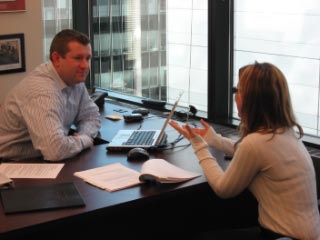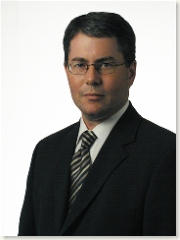One of the great benefits of social media for me is the way that it has allowed me to extend my networks. I have developed working relationships with people several time zones and thousands of miles away. We rountinely exchange information and collaborate. All without the need to travel or be in the same physical space.
And I spend a lot of time exploring the potential for social media to extend my capabilities even further.
However, Jack and Suzy Welch’s column in the April 16 issue of Business Week (registration required) provided me with a reminder that remote work has a very real limitation in companies and organizations. The Welch’s argue:
“…what you can’t do very well from home is lead. To lead, it’s no good blowing into town for important meetings and showing up at retreats. You have to muddle in the muck in between.”
 As the CEO of a PR and design firm with offices in two cities, I am regularly confronted with a fundamental challenge. How do I manage to stay connected enough with my employees that I can understand them and their state of mind and also convey a sense of the organization’s overall vision, direction and purpose?
As the CEO of a PR and design firm with offices in two cities, I am regularly confronted with a fundamental challenge. How do I manage to stay connected enough with my employees that I can understand them and their state of mind and also convey a sense of the organization’s overall vision, direction and purpose?
At one time, I used to try to make efficient use of my time by scheduling back to back meetings during my visit to the office in the other city. I’d arrive in the morning and have meetings scheduled right until the end of my trip. Lots of material covered. Lots of decisions.
And how did that work out? Some people came to dread my visits to the office. They knew that they’d be dragged away from the things that they wanted to get done in order to participate in one or more meetings with me. They also knew that these meetings would yield even more work as we decided on new initiatives and assigned responsibilities.
Eventually, I realized that while I was physically in the office, I was missing out on what was really going on with the people in the office. The water cooler chatter. The easy going banter about things that people cared about outside of the office. The things that would give me insight into the people I work with and what’s really important to them in their lives. (Remember, most of us work to live. Only a few really live to work.)
So, I changed my routine. I started to spend two days in the office on every trip. I scheduled fewer and shorter meetings. The rest of the time, I set myself up in a spare office and just spent my time working there – just like I would work in my own office in my home city.
 Then I watched my relationship with people begin to change. They saw that I was sitting there with an open door and they started to drop by to chat. Sometimes, it is just small talk or gossip. Other times, they raise work issues that are important to them. They pick the times that are best for them to raise issues with me. Things that I used to schedule in formal meetings began to move off my agenda and instead are raised in one to one meetings on the initiative of the people involved.
Then I watched my relationship with people begin to change. They saw that I was sitting there with an open door and they started to drop by to chat. Sometimes, it is just small talk or gossip. Other times, they raise work issues that are important to them. They pick the times that are best for them to raise issues with me. Things that I used to schedule in formal meetings began to move off my agenda and instead are raised in one to one meetings on the initiative of the people involved.
On top of this, I had the chance to join the brown bag boardroom lunches. To be part of the general discussion. And to just participate as one of many. A great leveller. A great way to learn more about people.
And that leaves me free to pick and choose the times when it is appropriate to convey information about the vision, direction and priorities that I see for the business. In the context of discussions. When they will make a contribution to moving things forward. With a greater likelihood that people who are already talking about something of importance to them will give me honest feedback. Honest feedback. The oxygen of intelligent decision-making.
So, yes, I try to get a great deal done via social software. But Jack and Suzy Welch are right when they say, “… for anyone who has dreams of leadership in any meaningful way, telecommuting can get you only so far. The road to the top is paved with being there.”

 I’m sitting in the cubicle farm in the Air Canada lounge at Pearson waiting for my flight. All around me, people are conducting business on the telephone. Beside me a woman is talking about a BtoB customer and problems with the account. Three feet across the screen, a lawyer is talking to a client about a potential deal. And at the cubicle behind me, an executive is talking about terminating an employee.
I’m sitting in the cubicle farm in the Air Canada lounge at Pearson waiting for my flight. All around me, people are conducting business on the telephone. Beside me a woman is talking about a BtoB customer and problems with the account. Three feet across the screen, a lawyer is talking to a client about a potential deal. And at the cubicle behind me, an executive is talking about terminating an employee.
 At first blush, this may sound like success, like a strong and healthy client relationship that has been extended for another year. But, when I hear this, the question I ask myself is, “Why are we dong the same thing as we did last year? Can’t we improve on last year’s program? Did we learn from last year and increase our knowledge, skills and value?”
At first blush, this may sound like success, like a strong and healthy client relationship that has been extended for another year. But, when I hear this, the question I ask myself is, “Why are we dong the same thing as we did last year? Can’t we improve on last year’s program? Did we learn from last year and increase our knowledge, skills and value?”

 Happily for me, I have had a very different experience with my bank. I’ve had an 11 year banking relationship with RBC. Even more remarkable, RBC has assigned the same account manager, Bill Helmer, to my account for that entire time. Over the years, he has been a source of advice and support. Bill has suggested ways that the bank could help me with my growth plans (yes, the money is offered when I don’t “need” it, but isn’t the art of management all about staying out of a situation in which you “need” financing.) And from time to time, he has reined me in, counseling that my ambitions might be ahead of my reach or that I needed to focus on fundamentals in order to have a solid foundation for those plans. He has invited me to events such as the economic briefing and networking events. And he has talked positively about my business to many of his own contacts.
Happily for me, I have had a very different experience with my bank. I’ve had an 11 year banking relationship with RBC. Even more remarkable, RBC has assigned the same account manager, Bill Helmer, to my account for that entire time. Over the years, he has been a source of advice and support. Bill has suggested ways that the bank could help me with my growth plans (yes, the money is offered when I don’t “need” it, but isn’t the art of management all about staying out of a situation in which you “need” financing.) And from time to time, he has reined me in, counseling that my ambitions might be ahead of my reach or that I needed to focus on fundamentals in order to have a solid foundation for those plans. He has invited me to events such as the economic briefing and networking events. And he has talked positively about my business to many of his own contacts.


 At this year’s
At this year’s 